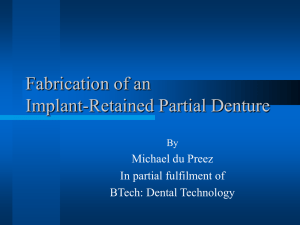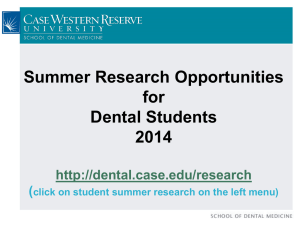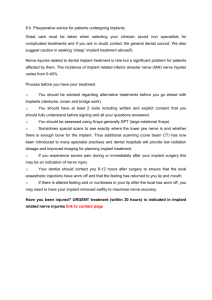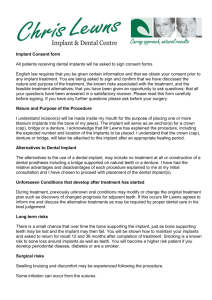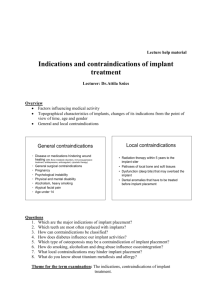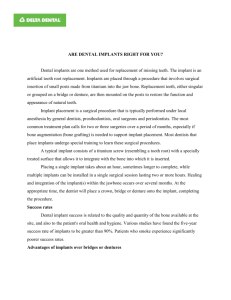File
advertisement
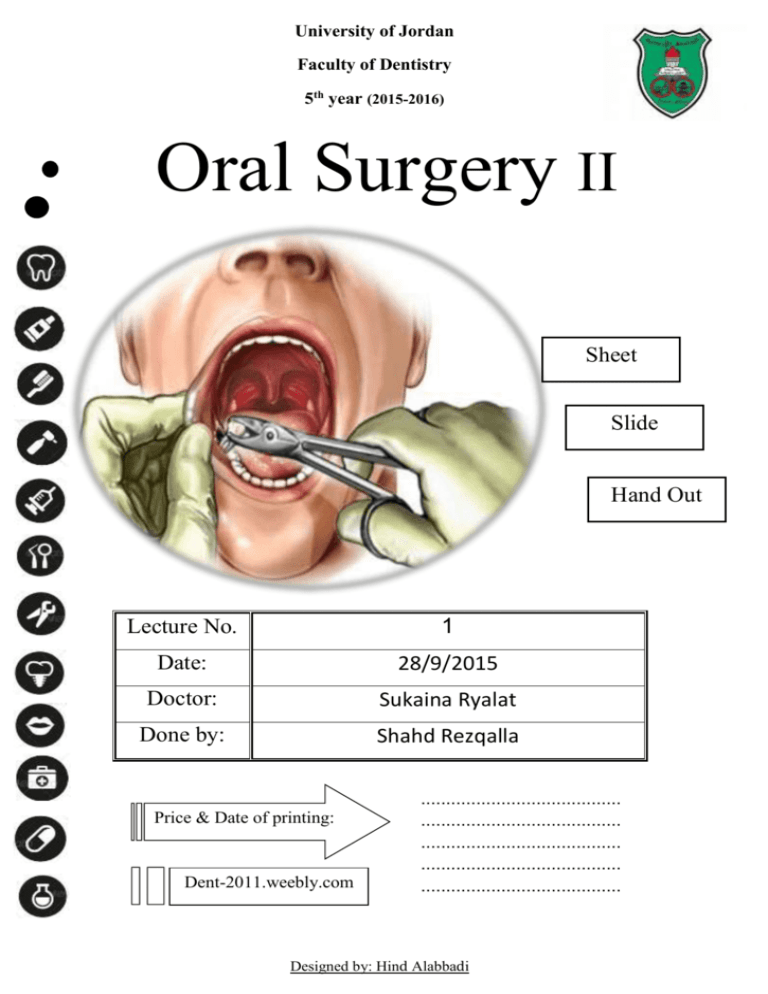
University of Jordan Faculty of Dentistry 5th year (2015-2016) Oral Surgery II Sheet Slide Hand Out Lecture No. 1 Date: 28/9/2015 Doctor: Sukaina Ryalat Done by: Shahd Rezqalla Price & Date of printing: Dent-2011.weebly.com ........................................ ........................................ ........................................ ........................................ ........................................ ........................................ ......... Designed by: Hind Alabbadi Dr.Sukaina Ryalat Shahd Rezqalla OS sheet 1 28/9/2015 Oral surgery grading system : There are competences about suturing that u will be performing in the dental anatomy lab room, there are grading system (A,B,C,D,F) for extractions. Implantology Nowadays implantology is considered the best method of replacing missing teeth. In the future it will face many advances including stem cell research, Implantology began when the concept of osseointegraion was introduced to the dental field . HISTORY OF IMPLANTOLGY They say that Implantology was known since 600 years BC , particularly by the Honduras. They found that there was some implanted teeth in the monuments of Indian people in the place of the central and lateral incisors , they also found some wires and plates implanted in the mandible to replace missing structures. Osseointegration is the only concept that made us understand and use implants in the first place , so what is osseointegration ? It’s the need of a strong relation between the implant and the surrounding structures ( bone ) , so titanium has been found the most suitable metal to achieve the best result of osseointegration. Why Titanium is the most suitable ? 1- Its mechanical strength is excellent to withstand occlusal forces 2- Its very biocompatible 3- High corrosion resentence 4- Doesn’t cause hypersensitivity or any immunological reaction , although there are some researches that say the implant failure can be as a result of rejection to some parts of the implant. The implant is basically a root like structure that is inserted in the dentoalveolus. Surface topography and chemical composition of titanium: Implants are now famous worldwide and every factory has its own way for making implants. Types of implants according to its surface structure : 1-Machined smoothed surfaces 2- Titanium sprayed surfaces ( TPS) 3-Sand blasted surface , to create a very rough surface and increase the surface are and by that we are creating more bond between the bond and the implant (more osseointegration ) 4-Inched surface and Coted surface Nowadays every factory chooses its own way of manufacturing that’s why we have German implant or English implant or French …… etc Ur choice of implants is affected by your medical knowledge and experience. At the end all we want is to have the titanium dioxide film which is an inert. recently they are applying the concept of active surfaces. 2 Dr.Sukaina Ryalat Shahd Rezqalla OS sheet 1 28/9/2015 Active surfaces are : titanium surfaces that are being activated by increasing the hydrophilicity of the surface . hydrophilicity Is achieved by certain proses and machines before inserting the implant. Surface irregularities are now achieved by : 1 – grit blasting : roughenning of the surface by ceramic or metalic particles. 2- acid itching : to increase the biomechanical interlocking between the bone and the implant up to this momnt we prefer the rough surface implant over the smooth surface implant . -all we need to achive at the end is a good 3D texture of the surface. The success rate of implants has overcome 95%, so one of the messages that u want to tell ur patients that sometimes its better to do an implant as its one of the best modalities for teeth replacement. In jordan and specially in the 19’s people were afraid of having implants because of : 3D 1-cancer phobia, although cancer has nothing to do with implants , besides you cant guarantee that the patient wont get cancer through out his / her life. 2-the cost, in the past implants used to be very expensive ,but now thrie prices are very reasoable. The failiure and succes of implants depends on how you handle it.all these high tech. mechanisms need delicate and presice handeling. Contamenation and poor infection control leads to higher failuire rates. Osseointegration: direct structural and functional connection between the living bone and the surface of implant. Endosteal dental implant : the most common type used , its a device inserted into the dental jaw bone to support the prosthesis. (tooth root analog), so what are the components of a dental implant ? 1- fexutre : it’s the root like structure that is insered into the endossous. 2- Abutmant : the device that supports the prosthitic tooth and connect it to the fexture . 3 Dr.Sukaina Ryalat Shahd Rezqalla OS sheet 1 28/9/2015 Types of abutments: A- Transmucosal abutment :the one that passes through te mucosa overlying the implant. B- temporary healing abutment :used for the anterior regeone But in this type we have to take care about the amount of loading as it affects the prosses of asseointegration in the first stage. 3- Screw : that attaches the abutment to the fexture. As for the procedure : 1- first we insert the root like structure into the bone 2- then we close over it (suturing ), and we leave it for about 3 to 4 or sometimes 5 months 3- then we reopen it and screw the abutment into the fixture 4- And finally we connect the prosthetic tooth over it second stage first stage Implant surgery proses is divided into : A- One stage implant surgery (single stage ):surgical placement of dental implant which is left exposed to the oral cavity “ transmucosal part “ , this protocol is used in the non submerged implant system. B- Two stage implant surgery (most commonly used ) : its illustrated in the steps mentioned above. *Note: non of the procedure is better than the other , each procedure is selected according to the case and the clinical experience of the DR. *note: non submerged implant is considered immediate implant, that is inserted after extraction immediately. As we said before , the most commonly used type of implant is Endosteal implant, and we also know that it has a root like structure, it might seem easy to do an implant procedure but actually its not, many dentists make the mistake of inserting the fixture without planning the amount of bone left , that’s why a lot of them end up inserting it into the ID canal, and causing more problems to the patient. NOW.- Brånemark is the scientist who first observed and discovered the proses of osseointegration Histological wise , osseointegration is a connection between bone and the metallic implant 4 Dr.Sukaina Ryalat Shahd Rezqalla - OS sheet 1 28/9/2015 Clinical wise : its the fixation of the fixture with alloplastic material to the bone during the functional loads.You also have to know that for every implant we Have to do preparation for the bone, and this preparation is planned too , because it depends on the anatomic structures in the area and the amount of bone and of course which jaw we are working on. There is also something called primary stability: to make sure that the implant is rigid and stable. *note :The first successful implant was in 1965. At that time we had different shapes AND DESIGNS of implants like aSUBPERIOSTEAL frames b- root like structure c- blade d-vents e- trans mandibular devices , but now non of which is clinically documented anymore because the most commonly used is the Endosteal type (root like) . - as for the application of osseointegration in other fields than dentistry , the first patient with missing ear was treated in 1977. What are the success criteria of an implant ? 12345- Primary Stability and rigidity Adequate radiographic bone level Lack of symptoms no infection , no persistent pain and no mobility . Normal probing depth around the implant. Patient motivation and oral hygiene maintenance. In this pic, u can notice that there is good bone and calcification around the apical 2/3 of the implant, but in the coronal part (arrows) u can notice the bone loss. Mostly this happens because the patient didn’t maintain good oral hygiene. As we said before, the success rate of implants is almost 95% , so why do we have failure cases all the time ? That depends on many factors like: ABCDE- Patient factor Clinical skills of the dentist Disinfection techniques Surgical procedure Oral hygiene *Note: smokers have 2 times higher failure rates than non-smokers *Note: although implants are initially designed to live for life, but still u have to inform the patient not to expect that every implant is going to live for life, u have to know that we have natural proses of bone loss around the implant. And that’s normal as long as its in certain average limits. - There is a difference between immediate placement and immediate loading: a- Immediate placement : means that the implant is inserted immediately after tooth extraction (in the same socket) b- Immediate loading : means attaching the prosthesis in the same time of implant insertion.(its considered provisional prostheses and u cant put heavy loads on it ) *Note: immediate placement is divided into: 1- immediate placement : at the same time 2- delayed immediate placement : after 6 to 10 days from the time of extraction. 3-delayed placement : after months or years from the time of extraction. 5 Dr.Sukaina Ryalat Shahd Rezqalla OS sheet 1 28/9/2015 *Note: immediately placed implants have much much higher success rates than delayed implants. but the problem is they are much harder to deal with and needs more clinical experience. Because in delayed placement all u have to do is to drill in the bone for a certain depth and diameter, but in a case of immediate placement u have to deal with the socket actual depth and diameter and sometimes you’ll end up doing bone grafts to fix the implant in a very wide socket. In case of a maxillary implant , you have to be very careful not to hit the maxillary sinus, as u know the maxilla is cancellous bone so if u hit it, negative pressure will be produced inside the sinus and this pressure can suck the implant into the sinus. How do implant bond to bone ? 1- bioactive implants : its future is targeting the concept of bone regeneration for bonding more than just bone integration and chemical bonding . 2- Chemical bonding :the good thing about it is that its rapid bonding 3-biomechanicla bonding: gradual bone regeneration against mechanical surface, (the one that we are using nowadays ) At the end if u have to be a good dentist and do successful implants u have to obtain all the success criteria for implants. Best wishes , and sorry for any mistakes Shahd rezqalla 6



